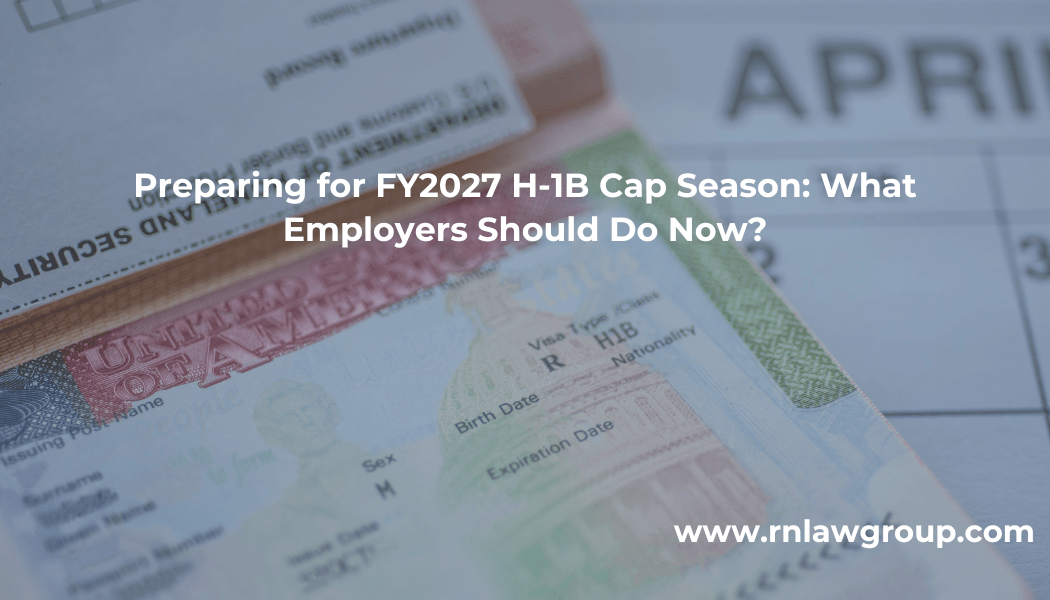
Preparing for FY2027 H-1B Cap Season: What Employers Should Do Now?
Introduction
Although the H-1B cap lottery for Fiscal Year (FY) 2027, for employment beginning October 1, 2026, won’t officially open until March 2026, employers and foreign nationals should begin preparations well in advance. With increased scrutiny from USCIS, evolving policy guidance, and shifting timelines, a proactive approach is key to a successful petition. This article outlines what employers should be doing in July 2025 to ensure readiness for next year’s H-1B cap season.
- Understand the Timeline: Key FY2027 H-1B Dates
While USCIS may adjust dates slightly year to year, the general timeline for the FY2027 H-1B cap season is as follows:
- Now (Summer 2025): Identify eligible candidates and evaluate positions for sponsorship.
- January – February 2026: Create myUSCIS online accounts and prepare candidate data.
- March 2026: Electronic H-1B registration opens (typically mid-March) and closes within a few weeks.
- April 2026 – June 2026: Employers can begin filing full petitions for selected registrants.
- October 1, 2026: Start of FY2027; earliest employment start date for cap-subject H-1B beneficiaries.
Why July 2025 Matters: Early preparation helps employers reduce errors, avoid wage and classification issues, and ensure strong documentation—ultimately increasing the chances of approval.
- Identify Eligible Candidates Now
Now is the time to:
- Review current F-1 OPT or STEM OPT employees nearing the end of their work authorization.
- Consider international candidates for open or future positions that require H-1B sponsorship
- Flag any candidates previously registered but not selected in past lotteries—they may be eligible again
Employers should gather key details such as:
- Educational credentials (especially foreign degrees and their U.S. equivalency)
- Immigration history (past visa denials, maintenance of status, etc.)
- Employment history and career trajectory
- Country of citizenship (some individuals may qualify under H-1B1 or other visa categories)
- Analyze the Job Role and Choose the Right SOC Code
With USCIS focusing more on wage level, job duties, and education alignment, employers must carefully select:
- The job title and duties
- The required degree
- The selected SOC (Standard Occupational Classification) code
- The wage level chosen
Choosing a weak or overly broad SOC code can lead to a Request for Evidence (RFE) or denial. Conducting this analysis early helps clarify:
- Whether the job qualifies as a “specialty occupation”
- Which wage level is appropriate based on job duties and experience requirements
- Whether additional evidence (such as expert opinion letters) may be needed
- Review Compensation and Conduct Prevailing Wage Comparisons
The Department of Labor (DOL) requires H-1B workers to be paid the prevailing wage or higher for their role and location. Compensation that doesn’t meet expectations for the job level and geographic region often triggers RFEs or denials.
Steps to take now:
- Run a prevailing wage analysis using tools like the DOL’s OFLC Wage Library
- Compare internal salary structures with DOL benchmarks
- Document how the wage level selected matches the complexity of the role and qualifications of the candidate
- Confirm Worksite Locations and Remote Work Compliance
Remote and hybrid work arrangements are now common, but they add complexity to H-1B compliance. Employers must:
- Ensure the Labor Condition Application (LCA) reflects every work location, including home offices if applicable
- Calculate prevailing wages based on the primary worksite, not just the headquarters
- Post required LCA notices at each worksite (physical or electronic, as appropriate)
Planning for this early avoids delays when it’s time to file.
- Assess Sponsorship Readiness
If your organization has never filed an H-1B petition before, or hasn’t done so recently, use the next few months to prepare:
- Enroll in E-Verify if you expect to hire F-1 STEM OPT workers as well
- Compile documents that demonstrate the legitimacy of the business (e.g., tax returns, incorporation docs, organizational charts)
- Understand your obligations under the LCA, such as maintaining a public access file and complying with anti-displacement rules
Working with immigration counsel now ensures your company is fully prepared for the legal and procedural requirements.
- Prepare for Lottery Alternatives
Because H-1B demand continues to outpace supply, many qualified candidates are not selected. Employers should start evaluating:
- Cap-exempt options through institutions of higher education or nonprofit research entities
- Other visa categories that may apply:
- L-1 for intracompany transferees
- TN for Canadian or Mexican professionals
- O-1 for individuals with extraordinary ability
- E-2/E-1 for treaty investors and traders
- International relocation or remote global roles if U.S. sponsorship isn’t immediately viable
Planning these contingencies early protects your workforce planning efforts.
- Align Internal Teams and Set Expectations
H-1B sponsorship is a cross-functional process involving HR, legal, and hiring managers. In July 2025, begin aligning expectations around:
- Candidate sponsorship priorities
- Internal workflows for registration and documentation
- Budget planning for filing fees and attorney costs
- Onboarding timelines tied to selection and approval
Advance alignment helps avoid rushed decisions or missed deadlines when March 2026 arrives.
Conclusion
The FY2027 H-1B cap season will unfold during calendar year 2026, but thoughtful planning should begin now in July 2025. By identifying candidates, evaluating job roles, confirming wage compliance, and preparing documentation in advance, employers can reduce risk and increase the likelihood of success.
Whether you’re a first-time sponsor or a seasoned employer, a proactive approach now will ensure you’re fully ready when the H-1B lottery opens in March 2026.
Need help preparing for FY2027?
Contact our team today to schedule a consultation and develop a customized H-1B cap strategy tailored to your workforce needs.
By: Felipe Jimenez
Felipe Jimenez is an Associate Attorney at Reddy Neumann Brown PC. He works in the Non-Immigrant Visa (NIV) Department where he assists clients through all phases of the non-immigrant visa process.
Reddy Neumann Brown PC has been serving the business community for over 20 years and is Houston’s largest immigration law firm focused solely on US. Employment-based immigration. We work with both employers and their employees, helping them navigate the immigration process quickly and cost-effectively.

